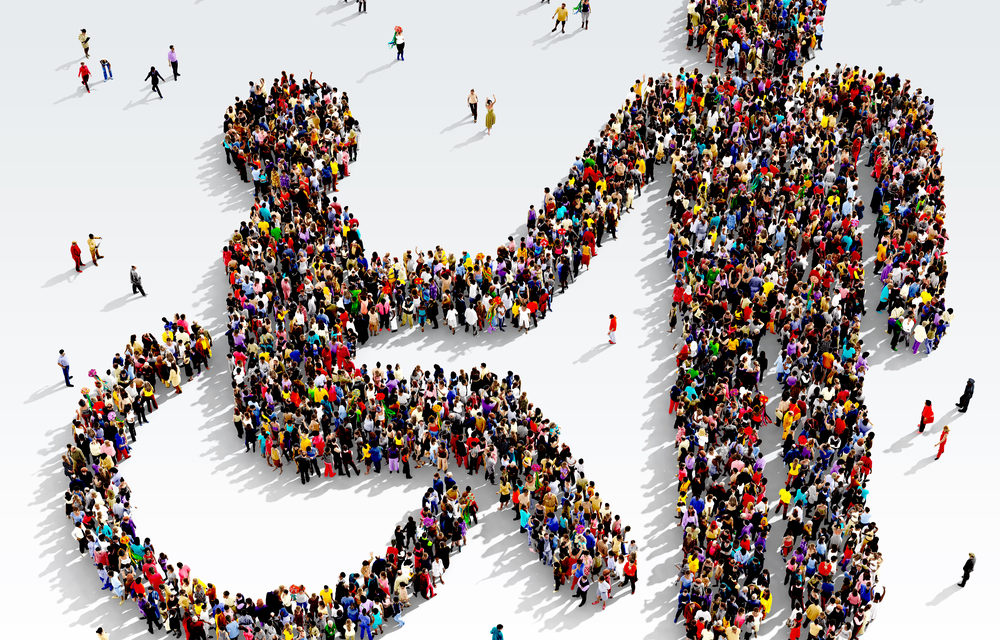July 2020 marks 30 years since the enactment of the Americans with Disabilities Act. In recognition of the tremendous impact of the bill, and acknowledgment that there is still much work to be done, AILA is republishing, with permission, a blog post from Diversity & Inclusion Committee member Caroline Ostrom, originally published on Think Immigration in March of 2019 as part of the Diversity & Inclusion blog post series.
My name is Caroline Ostrom, and I am a wife, mother, daughter, friend, solo immigration attorney and former Chair of the Minnesota/Dakotas Chapter of the American Immigration Lawyers Association (AILA). I am also a wheelchair user, so disabled is often the first thing that might come to mind to those initially meeting me.
As a member of AILA’s Diversity and Inclusion Committee, I wanted to share my thoughts on inclusion, drawing on my own experience. While there can be obvious physical barriers to practicing law with a disability — such as stairs to get to the podium to present at a Continuing Legal Education (CLE) session, or navigating a packed room with a crazy web of chairs to get to the microphone at a Board of Governors meeting — often the more difficult hurdles are the social challenges and perceptions.
With this in mind, I offer a few truisms and tips to counter this larger and more intractable issue, which can lead to people avoiding those with disabilities, rather than engaging with them and making real connections:
- A disability is not a measure of character or competence. It generally limits people in a narrow scope of activity, and not participation in all of the wider aspects of life.
- We experience a positive quality of life to the same degree as other people. Disability is not the deciding factor.
- We do not want pity, and we do not want to be unduly glorified for “courageously” going about our everyday life. (It is not “amazing” that I am a lawyer and go in to the office each day, ready to work and bringing my A game).
- Most people with a disability are amenable to answering questions about it to promote understanding, if the questions are within polite boundaries and are relevant to the conversation.
- If you think someone with a disability needs help, ask. It is ok to ask. It is not ok to assume and start pushing my wheelchair (with me in it) across the plaza. Ask how you can be of assistance, and then follow the person’s instructions.
- If you are going to be conversing at length with a person in a wheelchair, try to sit or place yourself at the person’s eye-level, if possible. It is hard to effectively network at social functions (post-CLE happy hours come to mind), where I am looking at everyone’s belts, and they are looking at the top of my head).
- If you are meeting someone who is visually impaired, introduce yourself, and anyone else who is with you. Before trying to shake hands, say something like, “I’d like to shake your hand.” Inform the person who is visually impaired when you are leaving. (These ideas seem very common sense, but you would be surprised).
- If speaking with someone with hearing loss, speak clearly while facing the person. Speak directly to the person, and not the interpreter, if one is present.
- Do not worry about using phrases that could be considered disability-related puns, such as “got to run” or “see what I mean.” Or, the slogan for AILA’s Diversity and Inclusion Committee: “Walk the Talk.” This is part of our common language and not offensive.
- The ABA has good resources for ways to make your practice and events more accessible and USCIS also has resources for disability accommodations for clients and inclusivity in hiring. Many organizations, including AILA, are updating their websites to be more accessible.
One last thing about disabilities – 15% of us have a disability, and most of us will experience one at some point in our life, if temporarily. So, incorporating ways to include those with disabilities into your practice as colleagues, employees, and clients, makes business sense and is the right thing to do.
Note: in writing this post, the author drew from her personal experience and information from the 2013 article “Straight Talk about Disability” by Judith Panko-Reis, Access Living of Metropolitan Chicago.







